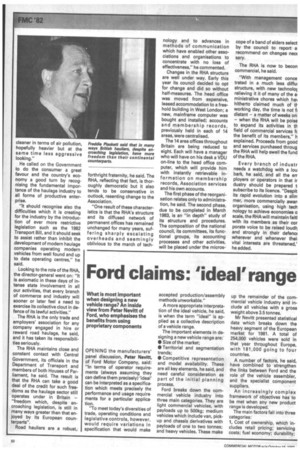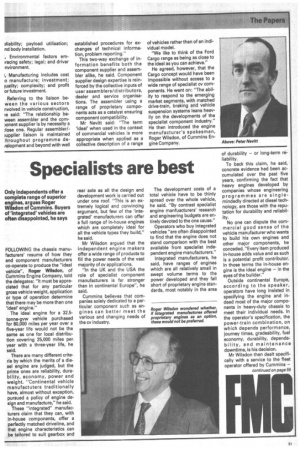Ford claims: 'ideal' range
Page 30

Page 31

If you've noticed an error in this article please click here to report it so we can fix it.
What is most important when designing a new vehicle range? An inside view from Peter Nevin of Ford, who emphasises the benefits from using proprietary components OPENING the manufacturers' panel discussion, Peter Nevitt, of Ford Motor Company, said: "In terms of operator requirements (always assuming they can define them precisely) 'ideal' can be interpreted as a specifica. tion which meets precisely the performance and usage require. ments for a particular applica. tion.
"To meet today's diversities of trade, operating conditions and legislative controls, however, would require variations in specification that would make accepted production/assembly methods unworkable," A more appropriate interpretation of the ideal vehicle, he said, is when the term "ideal" is applied as a collective description of a vehicle range.
The important elements in designing a new vehicle range are: • Size of the market; • Territorial and segmentation trends; • Competitive representation and model availability. These are all key elements, he said, and need careful consideration as part of the initial planning process.
Ford breaks down the commercial vehicle industry into three main categories. They are light commercial vehicles, with payloads up to 500kg; medium vehicles which include van, pickup and chassis derivatives with payloads of one to two tonnes; and heavy vehicles. These make up the remainder of the commercial vehicle industry and include all vehicles with a gross weight above 3.5 tonnes.
Mr Nevitt presented statistical data which breaks down the heavy segment of the European market for 1981. A total of 254,000 vehicles were sold in that year throughout Europe, with 181,000 going to four countries.
A number of factors, he said, have combined to strengthen the links between Ford and the role of the vehicle assembler, and the specialist component suppliers.
An increasingly complex framework of objectives has to be met when any new product range is developed.
The main factors fall into three categories: 1, Cost of ownership, which includes retail pricing; servicing costs; fuel economy; durability; 3liability; payload utilisation; nd body installation.
, Environmental factors emracing safety; legal; and driver ,nvironment.
Manufacturing includes cost o manufacture; investment; luality; complexity; and profit or future investment.
Referring to the liaison beween the various sectors nvolved in vehicle construction, le said: "The relationship bewean assembler and the corn)onent supplier is by necessity a ;lose one. Regular assembler/;upplier liaison is maintained :hroughout programme derelopment and beyond with well established procedures for exchanges of technical information, problem reporting."
This two-way exchange of information benefits both the component supplier and assembler alike, he said. Component supplier design expertise is reinforced by the collective inputs of user assemblers/distributors, dealer and service organisations. The assembler using a range of proprietary components acts as a catalyst ensuring component compatibility.
Mr Nevitt said: "The term 'ideal' when used in the context of commercial vehicles is more appropriate when applied as a collective description of a range of vehicles rather than of an individual model.
"We like to think of the Ford Cargo range as being as close to the ideal as you can achieve."
He agreed, however, that the Cargo concept would have been impossible without access to a wide range of specialist cv components. He went on: "The ability to respond to the emerging market segments, with matched drive-train, braking and vehicle suspension systems leans heavily on the developments of the specialist component industry." He then introduced the engine manufacturer's spokesman, Roger Wilsdon, of Cummins Engine Company.




















































































